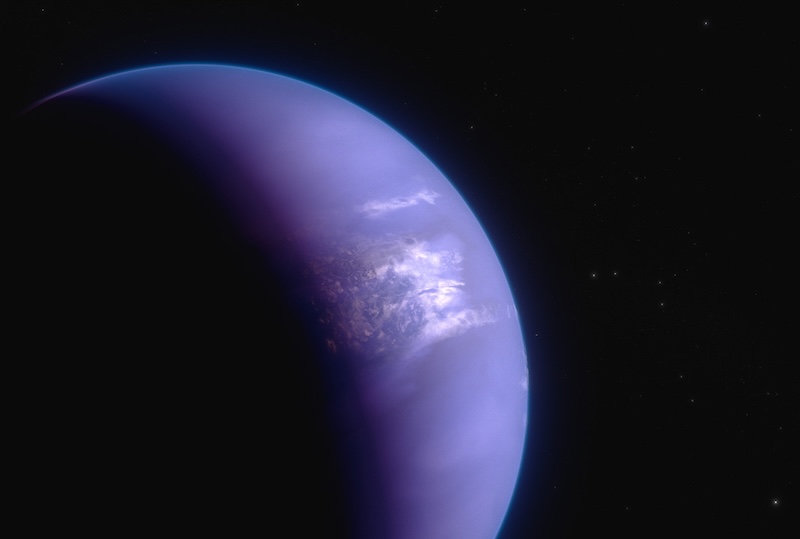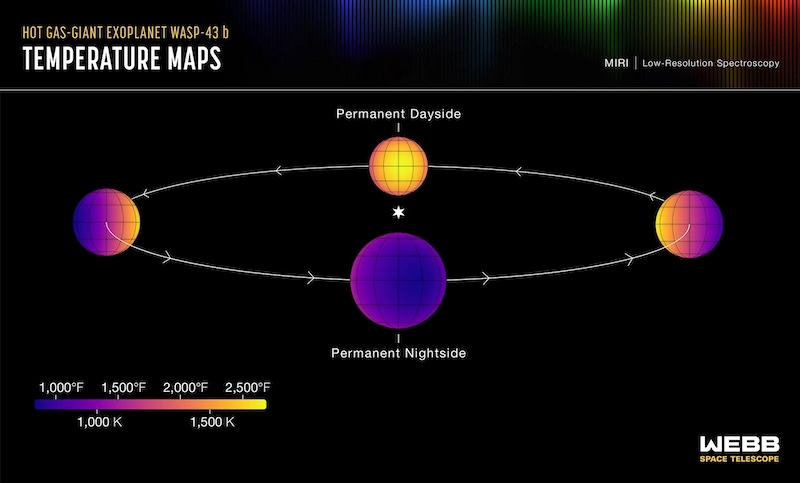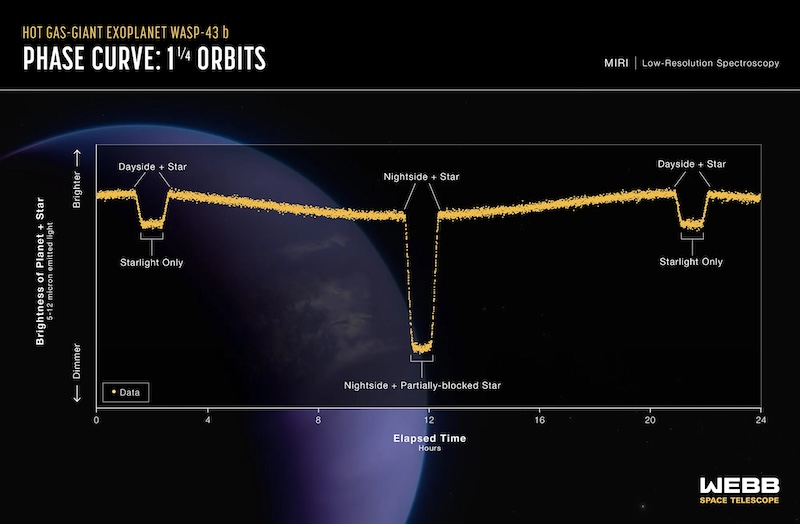
Weather on exoplanet WASP-43 b
We can’t yet directly see the weather on exoplanets. But for some closer worlds, the James Webb Space Telescope can analyze the atmosphere to determine what it’s made of and what the weather and climate are like. An international team of astronomers did just that for the exoplanet WASP-43 b. The researchers said on April 30, 2024, that the tidally locked “hot Jupiter” is cloudy on its nightside, but clear on its dayside. At 283 light-years away, it’s sizzling hot, with equatorial winds reaching supersonic speeds of 5,000 miles per hour (over 8,000 kph).
The journal Nature Astronomy published the new peer-reviewed findings on April 30, 2024.
Webb telescope maps weather on hot Jupiter exoplanet
WASP-43 b is a hot Jupiter, meaning it’s about the same size as Jupiter but much hotter. It’s hot because it orbits so close to its star at a distance of only 1.3 million miles (2 million km). That’s less than 1/25 the distance between Mercury and the sun. WASP-43 b is also tidally locked to its star. The same side always faces the star, just as the same side of the moon always faces Earth. Therefore, one side of the planet is in constant daylight, while the other is constant darkness.
The Hubble Space Telescope and Spitzer Space Telescope previously hinted at what WASP-43 b was like, but not with the same degree of detail as the Webb telescope. Taylor Bell, a researcher at the Bay Area Environmental Research Institute in California, said:
With Hubble, we could clearly see that there is water vapor on the dayside. Both Hubble and Spitzer suggested there might be clouds on the nightside. But we needed more precise measurements from Webb to really begin mapping the temperature, cloud cover, winds and more detailed atmospheric composition all the way around the planet.

Hot dayside, cooler nightside, clouds and supersonic winds
The researchers used mid-infrared data from Webb as well as 3D climate models and previous data from other telescopes to map the weather on WASP-43 b. The results suggest there are thick, high clouds on the nightside but clear skies on the dayside. Even though the nightside never sees sunlight, strong supersonic equatorial winds carry heat eastward from the dayside. Those winds blow at an incredible 5,000 miles per hour (over 8,000 kph).
The average temperature on the dayside is an estimated 2,300 degrees Fahrenheit (1,260 Celsius). Hot! The nightside is a little cooler, at 1,100 degrees F (600 C). Still not very habitable, though. Interestingly, the “hotspot” – the hottest point on the planet – has shifted slightly eastward from the spot that received the most stellar radiation. This is due to the same supersonic winds moving heat eastward.
The amount of detail about WASP-43 b’s weather that can be teased out of the data is impressive. Co-author Michael Roman at the University of Leicester in the U.K. said:
The fact that we can map temperature in this way is a real testament to Webb’s sensitivity and stability.

Water vapor and lack of methane on WASP-43 b
Webb confirmed the presence of water vapor in the planet’s atmosphere on both the dayside and nightside. But the observations also revealed a surprise: no methane. The dayside is too hot for methane. Scientists said that any carbon would be in the form of carbon monoxide instead. But methane should, however, be able to exist on the nightside. Yet Webb detected none. Why?
The answer likely, again, comes back to the supersonic winds. The winds are moving gases too fast for methane to form. As Joanna Barstow, co-author from the Open University in the U.K., explained:
The fact that we don’t see methane tells us that WASP-43 b must have wind speeds reaching something like 5,000 miles per hour. If winds move gas around from the dayside to the nightside and back again fast enough, there isn’t enough time for the expected chemical reactions to produce detectable amounts of methane on the nightside.
The new Webb observations provide new details not only about WASP-43 b, but about hot Jupiters in general. Even though there aren’t any in our own solar system, they are plentiful elsewhere in the Milky Way galaxy. They may be hot and uninhabitable, but they are a glimpse of which other kinds of fascinating and alien worlds can exist.
Bottom line: NASA’s Webb telescope has mapped the weather on WASP-43 b, a hot Jupiter exoplanet 283 light-years away. It’s blistering hot with 5,000-mile-per-hour winds.
Source: Nightside clouds and disequilibrium chemistry on the hot Jupiter WASP-43b
Read more: The unexpected, exotic characteristics of hot Jupiters
Read more: Hot Jupiters’ cloudy nights, blistering days
The post Exoplanet WASP-43 b weather is hot and wild first appeared on EarthSky.
from EarthSky https://ift.tt/N9sVX8O

Weather on exoplanet WASP-43 b
We can’t yet directly see the weather on exoplanets. But for some closer worlds, the James Webb Space Telescope can analyze the atmosphere to determine what it’s made of and what the weather and climate are like. An international team of astronomers did just that for the exoplanet WASP-43 b. The researchers said on April 30, 2024, that the tidally locked “hot Jupiter” is cloudy on its nightside, but clear on its dayside. At 283 light-years away, it’s sizzling hot, with equatorial winds reaching supersonic speeds of 5,000 miles per hour (over 8,000 kph).
The journal Nature Astronomy published the new peer-reviewed findings on April 30, 2024.
Webb telescope maps weather on hot Jupiter exoplanet
WASP-43 b is a hot Jupiter, meaning it’s about the same size as Jupiter but much hotter. It’s hot because it orbits so close to its star at a distance of only 1.3 million miles (2 million km). That’s less than 1/25 the distance between Mercury and the sun. WASP-43 b is also tidally locked to its star. The same side always faces the star, just as the same side of the moon always faces Earth. Therefore, one side of the planet is in constant daylight, while the other is constant darkness.
The Hubble Space Telescope and Spitzer Space Telescope previously hinted at what WASP-43 b was like, but not with the same degree of detail as the Webb telescope. Taylor Bell, a researcher at the Bay Area Environmental Research Institute in California, said:
With Hubble, we could clearly see that there is water vapor on the dayside. Both Hubble and Spitzer suggested there might be clouds on the nightside. But we needed more precise measurements from Webb to really begin mapping the temperature, cloud cover, winds and more detailed atmospheric composition all the way around the planet.

Hot dayside, cooler nightside, clouds and supersonic winds
The researchers used mid-infrared data from Webb as well as 3D climate models and previous data from other telescopes to map the weather on WASP-43 b. The results suggest there are thick, high clouds on the nightside but clear skies on the dayside. Even though the nightside never sees sunlight, strong supersonic equatorial winds carry heat eastward from the dayside. Those winds blow at an incredible 5,000 miles per hour (over 8,000 kph).
The average temperature on the dayside is an estimated 2,300 degrees Fahrenheit (1,260 Celsius). Hot! The nightside is a little cooler, at 1,100 degrees F (600 C). Still not very habitable, though. Interestingly, the “hotspot” – the hottest point on the planet – has shifted slightly eastward from the spot that received the most stellar radiation. This is due to the same supersonic winds moving heat eastward.
The amount of detail about WASP-43 b’s weather that can be teased out of the data is impressive. Co-author Michael Roman at the University of Leicester in the U.K. said:
The fact that we can map temperature in this way is a real testament to Webb’s sensitivity and stability.

Water vapor and lack of methane on WASP-43 b
Webb confirmed the presence of water vapor in the planet’s atmosphere on both the dayside and nightside. But the observations also revealed a surprise: no methane. The dayside is too hot for methane. Scientists said that any carbon would be in the form of carbon monoxide instead. But methane should, however, be able to exist on the nightside. Yet Webb detected none. Why?
The answer likely, again, comes back to the supersonic winds. The winds are moving gases too fast for methane to form. As Joanna Barstow, co-author from the Open University in the U.K., explained:
The fact that we don’t see methane tells us that WASP-43 b must have wind speeds reaching something like 5,000 miles per hour. If winds move gas around from the dayside to the nightside and back again fast enough, there isn’t enough time for the expected chemical reactions to produce detectable amounts of methane on the nightside.
The new Webb observations provide new details not only about WASP-43 b, but about hot Jupiters in general. Even though there aren’t any in our own solar system, they are plentiful elsewhere in the Milky Way galaxy. They may be hot and uninhabitable, but they are a glimpse of which other kinds of fascinating and alien worlds can exist.
Bottom line: NASA’s Webb telescope has mapped the weather on WASP-43 b, a hot Jupiter exoplanet 283 light-years away. It’s blistering hot with 5,000-mile-per-hour winds.
Source: Nightside clouds and disequilibrium chemistry on the hot Jupiter WASP-43b
Read more: The unexpected, exotic characteristics of hot Jupiters
Read more: Hot Jupiters’ cloudy nights, blistering days
The post Exoplanet WASP-43 b weather is hot and wild first appeared on EarthSky.
from EarthSky https://ift.tt/N9sVX8O

Aucun commentaire:
Enregistrer un commentaire